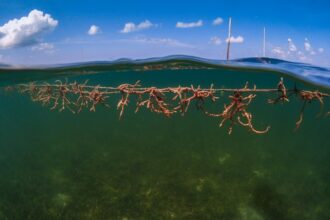A thermocline is a distinct layer within a body of water where the temperature changes rapidly with depth. This phenomenon typically occurs in oceans, lakes, and other large water bodies, creating a gradient that separates warmer surface waters from the cooler, denser waters below. The thermocline can vary in depth depending on geographical location, season, and weather conditions, but it generally represents a significant transition zone.
In many cases, the thermocline can be found at depths ranging from a few meters to several hundred meters, depending on the specific characteristics of the water body. The presence of a thermocline has profound implications for marine life, as it influences the distribution of nutrients and the behavior of various species. Fish and other aquatic organisms often congregate around this layer due to the availability of food and optimal living conditions.
However, beyond its ecological significance, the thermocline also plays a crucial role in military operations, particularly in naval warfare. Understanding the dynamics of thermoclines is essential for strategists and operators who seek to leverage this natural phenomenon for tactical advantages.
Key Takeaways
- Thermocline is a distinct layer in the ocean where temperature changes rapidly with depth
- Thermoclines can affect stealth operations by distorting sonar signals and making it difficult to detect submarines
- Sonar detection can be impacted by thermoclines as they can reflect, refract, or absorb sound waves
- Utilizing thermoclines for stealth tactics can involve hiding within or exploiting the properties of the thermocline layer
- Understanding thermoclines is crucial in naval warfare for evading detection and conducting stealth operations
How do thermoclines affect stealth operations?
Thermoclines significantly impact stealth operations by creating a natural barrier that can obscure the presence of submarines and other underwater vehicles. The temperature gradient established by the thermocline can affect sound propagation, making it more challenging for enemy forces to detect submerged vessels. As sound travels differently through layers of varying temperatures, submarines operating within or beneath the thermocline can exploit this phenomenon to remain undetected while conducting surveillance or reconnaissance missions.
Moreover, the ability to maneuver within the thermocline allows submarines to maintain a low profile while still gathering intelligence or preparing for an attack. By carefully navigating these layers, operators can minimize their acoustic signature and reduce the likelihood of detection by enemy sonar systems. This strategic advantage is particularly valuable in high-stakes environments where stealth is paramount for mission success.
The impact of thermoclines on sonar detection
Sonar systems rely on sound waves to detect and locate underwater objects, including submarines and other vessels. The presence of a thermocline can significantly alter the effectiveness of sonar detection by creating a phenomenon known as sound channeling. In this scenario, sound waves can be refracted or bent around the thermocline, leading to reduced detection capabilities for sonar operators.
As a result, submarines operating within or just below the thermocline can effectively mask their presence from enemy sonar systems.
These variations can lead to unpredictable sound propagation patterns, making it difficult for sonar operators to accurately pinpoint the location of submerged vessels.
Consequently, understanding how thermoclines influence sonar detection is crucial for both offensive and defensive strategies in naval warfare.
Utilizing thermoclines for stealth tactics
| Stealth Tactic | Advantages | Challenges |
|---|---|---|
| Utilizing Thermoclines | Difficult for sonar detection, reduces acoustic footprint | Requires precise depth control, limited effectiveness in shallow waters |
Naval strategists have long recognized the potential of utilizing thermoclines as a tactical advantage in stealth operations. By understanding the characteristics of the thermocline in specific operational areas, submarines can plan their movements to maximize concealment from enemy detection systems. For instance, during missions that require stealthy approaches to enemy shores or critical infrastructure, submarines can position themselves within the thermocline to take advantage of its sound-dampening properties.
For example, adjusting speed and depth can help minimize noise production and maintain an optimal position within the thermocline. By carefully managing these factors, submarines can effectively evade detection while still achieving their operational objectives.
The role of thermoclines in submarine operations
Submarines are designed to operate stealthily beneath the surface of the water, and thermoclines play a vital role in enhancing their operational effectiveness. By understanding the thermal structure of the ocean or other bodies of water, submarine crews can make informed decisions about their depth and speed to optimize stealth. The ability to navigate through or beneath a thermocline allows submarines to exploit favorable conditions for evading enemy detection while remaining capable of executing their missions.
In addition to evasion tactics, thermoclines also influence submarine weapon systems and operational planning. For instance, when launching torpedoes or conducting other offensive operations, understanding how sound travels through different water layers can inform targeting decisions. Submarine commanders must consider these factors when planning engagements to ensure that they maximize their chances of success while minimizing exposure to enemy countermeasures.
Thermoclines and their effect on underwater vehicles
The impact of thermoclines extends beyond traditional submarines to include various types of underwater vehicles, such as unmanned underwater vehicles (UUVs) and remotely operated vehicles (ROVs). These vehicles often rely on sonar systems for navigation and data collection, making them susceptible to the same challenges posed by thermoclines as manned submarines. Understanding how these temperature gradients affect sound propagation is essential for optimizing the performance of underwater vehicles during missions.
Moreover, UUVs and ROVs can also leverage thermoclines for stealthy operations. By operating at specific depths that correspond with favorable thermal conditions, these vehicles can minimize their acoustic signatures and enhance their ability to gather intelligence without being detected. This capability is particularly valuable in reconnaissance missions or when conducting surveys in contested waters.
The importance of understanding thermoclines in naval warfare
In modern naval warfare, understanding thermoclines is crucial for both offensive and defensive strategies. As naval forces increasingly rely on advanced technology and sophisticated weaponry, knowledge of environmental factors such as thermoclines becomes essential for maintaining a tactical edge. Commanders must consider how these temperature gradients affect not only their own operations but also those of potential adversaries.
Furthermore, as naval engagements become more complex and multifaceted, the ability to adapt tactics based on environmental conditions will be paramount. By incorporating an understanding of thermoclines into operational planning, naval forces can enhance their effectiveness while minimizing vulnerabilities. This knowledge will be vital in ensuring that they remain competitive in an ever-evolving maritime landscape.
How thermoclines can be used to evade detection
Evading detection is a primary objective for any military operation conducted underwater. Thermoclines provide an effective means for achieving this goal by creating natural barriers that disrupt sound propagation. Submarines and other underwater vehicles can exploit these layers by carefully selecting their operating depths and speeds to remain concealed from enemy sonar systems.
In practice, this might involve maneuvering just below the thermocline during critical phases of an operation or using it as a shield while approaching enemy positions. By taking advantage of the unique acoustic properties associated with these temperature gradients, operators can significantly reduce their chances of being detected while still executing their missions effectively.
Challenges and limitations of using thermoclines for stealth operations
While thermoclines offer significant advantages for stealth operations, they are not without challenges and limitations. One major concern is that thermoclines are not static; they can shift due to changes in weather patterns or ocean currents. This variability means that operators must continuously monitor environmental conditions to ensure they are leveraging the thermocline effectively.
Additionally, while operating within a thermocline may reduce detection risks from sonar systems, it does not eliminate them entirely. Advanced sonar technologies may still be capable of detecting vessels operating within these layers under certain conditions. Therefore, operators must remain vigilant and adaptable in their tactics to account for potential changes in enemy capabilities or environmental factors.
The future of thermocline technology in stealth operations
As technology continues to advance, so too does the potential for utilizing thermoclines in stealth operations. Future developments may include enhanced sensors capable of providing real-time data on thermal structures within bodies of water, allowing operators to make more informed decisions about their movements and tactics. Additionally, advancements in artificial intelligence could enable automated systems to analyze environmental conditions rapidly and adjust operational parameters accordingly.
Moreover, as naval warfare evolves with new technologies such as unmanned systems and advanced weaponry, understanding how to exploit natural phenomena like thermoclines will remain critical for maintaining a strategic advantage. The integration of cutting-edge technology with traditional naval tactics will likely shape the future landscape of underwater operations.
The significance of thermoclines in modern warfare
In conclusion, thermoclines play a pivotal role in modern naval warfare by influencing stealth operations, sonar detection capabilities, and overall strategic planning. Their unique properties create opportunities for submarines and underwater vehicles to evade detection while conducting critical missions. As military forces continue to adapt to changing technological landscapes and operational environments, understanding and leveraging thermoclines will remain essential for maintaining a competitive edge.
The significance of thermoclines extends beyond mere tactical advantages; they represent a fundamental aspect of underwater warfare that requires careful consideration by military planners and operators alike. As advancements in technology continue to unfold, the ability to harness the power of natural phenomena like thermoclines will undoubtedly shape the future of naval operations and redefine strategies in modern warfare.
The role of thermoclines in stealth technology is a fascinating topic, particularly in how submarines utilize these layers of water to evade detection. For a deeper understanding of this subject, you can explore the article on stealth tactics and underwater operations at this link. This resource provides valuable insights into how thermoclines can affect sonar detection and enhance the stealth capabilities of naval vessels.
WATCH THIS! The Secret Russian Weapon That Terrifies NATO
FAQs
What is a thermocline?
A thermocline is a distinct layer in a body of water where the temperature changes rapidly with depth. This can create a barrier that affects the movement of sound waves and can be used to hide submarines and other underwater objects.
How do thermoclines affect stealth in the water?
Thermoclines can affect stealth in the water by creating a barrier that can absorb or reflect sound waves, making it difficult for sonar systems to detect objects hidden beneath the thermocline.
Why are thermoclines important in military operations?
Thermoclines are important in military operations because they can be used to hide submarines and other underwater objects from detection by enemy sonar systems, providing a stealth advantage.
Can thermoclines be used for civilian purposes?
Thermoclines can also be used for civilian purposes, such as in oceanography and marine biology research, to study the behavior of marine life and the movement of ocean currents.
How are thermoclines detected and utilized for stealth purposes?
Thermoclines are detected using specialized sonar equipment that can identify changes in water temperature and density. Once detected, submarines and other underwater objects can use the thermocline to hide from enemy detection systems.




